“Amateur” Photographer Donates 36,000 Photos to the Church
Contributed By Trent Toone, Deseret News
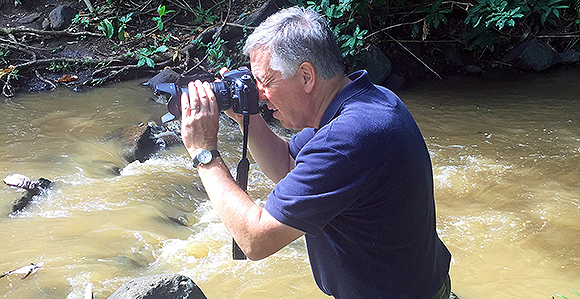
Kenneth Mays in Hawaii composing an image at a historic Church site. Photo courtesy of Kenneth Mays.
Article Highlights
- The images can be a blessing for Latter-day Saints, gospel teachers, and families.
- The photos show how the sites have changed over the course of 30 years.
“Kenny’s generosity in sharing this with the Church History Department, along with the work that has gone into making it searchable, really deserves as wide an audience as possible.” —Jacob Olmstead, curator of Church historic sites
Kenneth Mays started in 1985 using a family camera to capture “souvenirs” as he visited Church history sites. He also figured the photos would be useful as he taught the Doctrine and Covenants in his seminary classroom.
Nearly 35 later, the retired seminary teacher’s photo collection includes more than 50,000 images. Mays recently donated 36,000 photos to the Church History Library of The Church of Jesus Christ of Latter-day Saints with the hope that they may preserve Church history and be a resource for the “sweet, pure, humble Latter-day Saints all over the world,” he said.
“I’ll tell you right now, if I get a good image, one that’s artistic and aesthetically pleasing, it’s probably an accident,” Mays said.
Mays’s collection will be accessible in the digital photograph collection (PH 9809) in the Church History Catalog. His images have also been featured for several years in an ongoing Deseret News faith feature called “Picturing History.”
Jacob Olmstead is a curator of historic sites in the Church History Department. He said Mays’s collection is an important acquisition for the Church and the historic sites division.
“It’s easily the most complete photographic record of the places where the events of the Restoration took place in existence, by a long shot,” Olmstead said. “It represents a lifetime of work and devotion for Kenny to follow his passion, to document and locate these places, and then capture them photographically.
Olmstead said the collection’s value is twofold. First, for Latter-day Saints, gospel teachers and families, the images can be a blessing.
Second, the photos show how the sites have changed over the course of 30 years, which is helpful in documenting the history of the Church, Olmstead said.
“Kenny has done this legwork to find not only these principal sites of the Restoration, but he’s also gone out of his way to find lesser-known sites, markers, monuments, burial sites in seven countries,” Olmstead said. “Kenny’s generosity in sharing this with the Church History Department, along with the work that has gone into making it searchable, really deserves as wide an audience as possible. I can’t speak highly enough of Kenny, his willingness to share and the value this can have for both historians and the rank-and-file Latter-day Saints.”
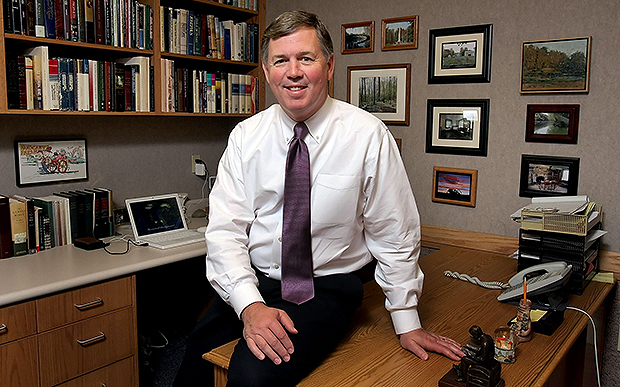
Kenneth Mays has been photographing Church history sites for more than a 35 years. He poses in his old office at the Salt Lake University Institute of Religion in 2008. Photo by Scott G. Winterton, Deseret News.
Mays said he was inspired by the late President Gordon B. Hinckley’s charge to “Let us never forget” the Saints who went before, remarks he delivered at a Pioneer Day Commemoration Concert in 2001.
“We must never allow recognition of their trials, of their sacrifices, of their tenacity, of their faith and their prayers in establishing this great community to lapse or be forgotten,” President Hinckley said.
Five years later, President Hinckley used the same phrase again.

Kenneth Mays with his camera in Maine. Photo courtesy of Kenneth Mays.
“In all of our celebrations of the 24th of July, let us never forget it. Let us remember with gratitude and reverent respect those who have gone before us, who paid so dear a price in laying the foundation for that which we enjoy this day.”
These thoughts by President Hinckley were the “driving force” behind Mays’s passion for documenting Church history, he said.
More than 30 years and thousands of photos later, one of Mays’s most spiritual moments came in Wyoming, Nebraska, an outfitting station where pioneer immigrants coming from Europe would start their trek west. Today the marker stands on a privately-owned farm. While taking photos, Mays felt a strong connection to the pioneers who had walked there.
“I’ve had wonderful experiences at the Sacred Grove and other times felt nothing in the Sacred Grove,” Mays said. “But the most powerful spirit I ever felt was at Wyoming, Nebraska.”

One of Kenneth Mays's most memorable experiences came taking photos at this pioneer site in Wyoming, Nebraska. Photo by Kenneth Mays.
Another site, the crumbling walls of the James Smithies home where Apostle Heber C. Kimball gave the first baby blessing in England, was difficult to find.
“That took hours to find. I ended up on farms, out in fields, and it was the wrong place. Finally I found it,” Mays said. “When I was asked by the mission president how to get there, I said I couldn’t tell you. I just drove and wound around for a few hours. I couldn’t tell you where I was.”

The James Smithies home in England was very difficult for Kenneth Mays to find. Photo by Kenneth Mays.
Other memorable historic site visits include the room where the King James Bible was translated; climbing a mountain to get a view of Lee’s Ferry on the Honeymoon Trail; taking a photo of the King and Queen of Tonga at the dedication of a Church monument; the dedication of a marker at the Wisconsin Pineries; the Lemuel Durfee home, which is not longer extant; the dedication of the Richmond Jail site, which he photographed from a neighbor’s window; and the home where John Taylor, third president of the Church, died.
“I think of a sweet person I’ll never meet in Mongolia or Africa that will never visit these sites,” Mays said. “If any images I contribute can help them, it would be a marvelous blessing to me.”
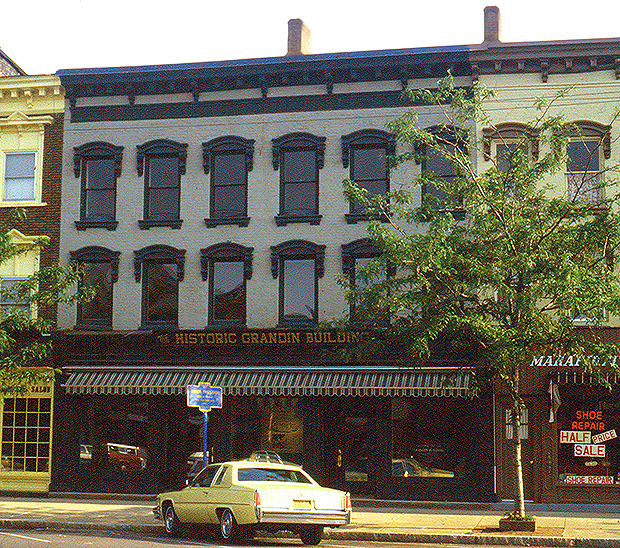
The Book of Mormon publication site before it was restored. Photo by Kenneth Mays.

The Book of Mormon publication site after the building was restored. Photo by Kenneth Mays.

The Book of Mormon Printing Office. Photo by Kenneth Mays.

A newly identified home where Brigham Young lived for four years. Photo by Kenneth Mays.

Kenneth Mays, far right, at the dedication of a marker at Wisconsin Pineries. Photo courtesy of Kenneth Mays.

The Lemuel Durfee home in Palmayra, New York, which is no longer extant. Photo by Kenneth Mays.

Photographer Kenneth Mays had to climb a mountain to capture this view of Lee’s Ferry on the Honeymoon Trail. Photo by Kenneth Mays.

The room where some of the King James Bible was translated. Photo by Kenneth Mays.

The Thomas Roueche home where John Taylor, third president of the Church, died. The home has since been torn down. Photo by Kenneth Mays.

A second pioneer site at Wyoming, Nebraska. Photo by Kenneth Mays.
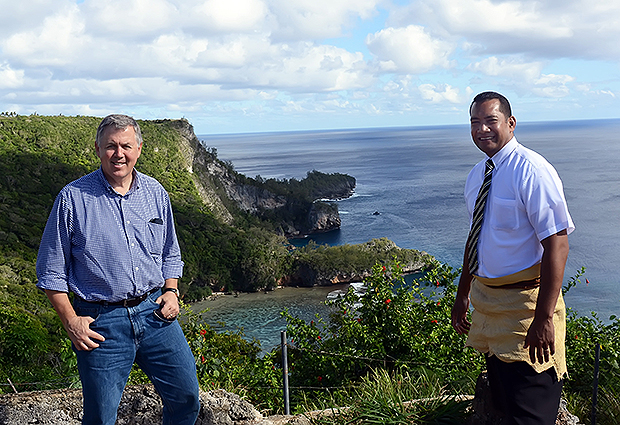
Kenneth Mays, left, in Tonga with Kapilon (Loni) Savou, a Latter-day Saint stake president from the area. Photo courtesy of Kenneth Mays.

The King of Tonga, his son, and his wife at the dedication of a Latter-day Saint monument in Tonga. Photo by Kenneth Mays.

Kenneth and Marie Mays. Photo courtesy of Kenneth Mays.
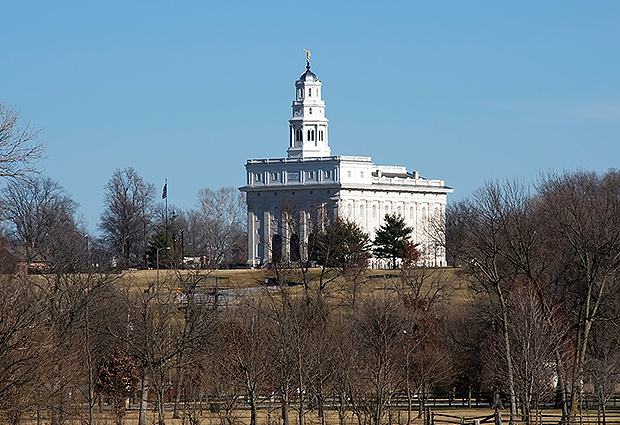
View of the Nauvoo Temple. Photo by Kenneth Mays.
